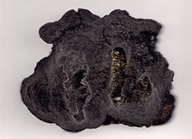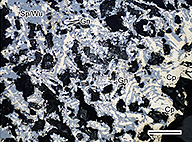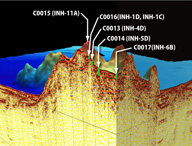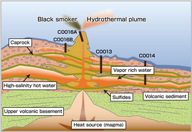

Hydrothermal vent chimney artificial collected

Sphalerite ((Zn,Fe)S)
Chalcopyrite (CuFeS2)
Galena (PbS)
Wurtzite ((Zn,Fe)S)
Submarine Resources Research Project, joined with the Institute of Biogeosciences (Biogeos) and the Precambrian Ecosystem Laboratory Unit, managed to analyze the mode of formation and chemical composition of the chimneys that were newly formed in the artificial vents installed during the IODP Expedition 331 (Deep Hot Biosphere -Season 1) carried out by the Scientific Deep Sea Drilling Vessel CHIKYU in September 2010, in the effort to push forward with research and development of basic technologies for utilizing subseafloor thermal fluid as sustainable resources.
The artificial hydrothermal vents created in the Iheya North hydrothermal field during the IODP expedition had been monitored for more than one year to ascertain the spurting variations and chemical composition of hydrothermal fluid.
It was found that the chimneys, with remarkably rich black ore minerals, were quickly formed and grew larger within a short period of time in the hydrothermal vents created by direct spurting from the hydrothermal fluid reservoir which forms a black ore layer below the sea bottom surface. This points to the possibility of a new sustainable method of recovering useful mineral resources from subseafloor hydrothermal fields.
The outcomes are expected to contribute significantly to the construction of the foundation for using the useful mineral resources in subseafloor hydrothermal fields.
The artificial hydrothermal vents created in the Iheya North hydrothermal field during the IODP expedition had been monitored for more than one year to ascertain the spurting variations and chemical composition of hydrothermal fluid.
It was found that the chimneys, with remarkably rich black ore minerals, were quickly formed and grew larger within a short period of time in the hydrothermal vents created by direct spurting from the hydrothermal fluid reservoir which forms a black ore layer below the sea bottom surface. This points to the possibility of a new sustainable method of recovering useful mineral resources from subseafloor hydrothermal fields.
The outcomes are expected to contribute significantly to the construction of the foundation for using the useful mineral resources in subseafloor hydrothermal fields.

Proceedings of the Integrated Ocean Drilling Program
Expedition 331 Deep Hot Biosphere
The Digital Object Identifier (DOI) for the report is
doi:10.2204/iodp.proc.331.2011
>>Expedition-related bibliography
Expedition 331 Deep Hot Biosphere
The Digital Object Identifier (DOI) for the report is
doi:10.2204/iodp.proc.331.2011
>>Expedition-related bibliography

The one-year publication moratorium period (for exclusive use by shipboard science party) for the data and samples obtained from Expedition 331 has expired. Now the data is accessible from the following database. To use the samples for scientific or educational purposes, please send a request to IODP.
>>Chikyu Data Center

>>Chikyu Data Center


Integrated Ocean Drilling Program Expedition 331 Preliminary Report
Deep Hot Biosphere
1 September-4 October 2010
The Digital Object Identifier (DOI) for the report is
doi:10.2204/iodp.pr.331.2010

Deep Hot Biosphere
1 September-4 October 2010
The Digital Object Identifier (DOI) for the report is
doi:10.2204/iodp.pr.331.2010


Expedition 331 aimed to drill and sample hydrothermally active mounds to obtain evidence for microbial communities, including their biomass and ecosystem roles and functions. The drilling and coring were conducted at five sites in the Iheya North field in the Okinawa Trough: C0013, C0014, C0015, C0016 and C0017.
Two of the drilled boreholes were fitted with casing pipes (pipes for borehole wall protection), for future installation of observatories for chemical and microbial studies.
The expedition was led by Co-Chief Scientists Dr. Ken Takai, JAMSTEC and Prof. Mike Mottl, University of Hawaii, and joined by 25 scientists from Japan, U.S., China, Australia and Europe.
1. Sub-seafloor hydrothermal fluid structure and hydrothermal alternation zone
The temperature readings from the bottom of the borehole were higher than those expected at C0013 (about 100 m east to the center of a high-temperature hydrothermal fluid plume), and C0014 (350 m further east of C0013). There, the Expedition recovered cores of volcanic sediment containing hydrothermally-altered sulfate minerals. Horizontal flows of hot fluids were also found at several depths. This indicate that in the eastern Iheya North hydrothermal field, there are several layers of caprock, where high-temperature vent fluids are trapped but can migrate laterally. Such interaction of hydrothermal waters and seawater passing through the layers causes hydrothermal alteration of rock (hydrothermal alteration zone).
2. Sub-seafloor hydrothermal fluid reservoir
The chemical composition of pore water contained in the cores revealed the presence of lighter vapor-rich water in the upper portion of the hydrothermal fluid reservoir; heavier high-salinity water accumulated at the bottom.
It is theorized that a hot fluid with high salinity sinks to the bottom of the hydrothermal fluid reservoir. The drilling into the hydrothermal mounds in Expedition 331 brought back the first direct evidence for this theory. The huge and deep expanse of the hydrothermal fluid reservoir in Iheya has also overturned the concept that the extent of fluid circulation and its flux volume are relatively small at plate convergence boundaries, such as the Okinawa Trough.
3. Distribution and mineralogy of hydrothermal sulfide minerals: clues to uncover the hydrothermal ore genesis.
The recovered cores contained a wide range of minerals composed of hydrothermally synthesized metal sulfides, providing clues to the chemical and depositional environment. It is commonly known that hydrothermal mounds (e.g. Site C0016) consist mainly of sulfide minerals. The Iheya hydrothermal system is not an exception; especially at C0013 and C0014, veins of sulfide minerogenic layers are extending through the bottom portion of the thick hydrothermal alteration zone. The finding has scientific significance as it may reveal the processes of the generation of hydrothermal deposits.
Two of the drilled boreholes were fitted with casing pipes (pipes for borehole wall protection), for future installation of observatories for chemical and microbial studies.
The expedition was led by Co-Chief Scientists Dr. Ken Takai, JAMSTEC and Prof. Mike Mottl, University of Hawaii, and joined by 25 scientists from Japan, U.S., China, Australia and Europe.
1. Sub-seafloor hydrothermal fluid structure and hydrothermal alternation zone
The temperature readings from the bottom of the borehole were higher than those expected at C0013 (about 100 m east to the center of a high-temperature hydrothermal fluid plume), and C0014 (350 m further east of C0013). There, the Expedition recovered cores of volcanic sediment containing hydrothermally-altered sulfate minerals. Horizontal flows of hot fluids were also found at several depths. This indicate that in the eastern Iheya North hydrothermal field, there are several layers of caprock, where high-temperature vent fluids are trapped but can migrate laterally. Such interaction of hydrothermal waters and seawater passing through the layers causes hydrothermal alteration of rock (hydrothermal alteration zone).
2. Sub-seafloor hydrothermal fluid reservoir
The chemical composition of pore water contained in the cores revealed the presence of lighter vapor-rich water in the upper portion of the hydrothermal fluid reservoir; heavier high-salinity water accumulated at the bottom.
It is theorized that a hot fluid with high salinity sinks to the bottom of the hydrothermal fluid reservoir. The drilling into the hydrothermal mounds in Expedition 331 brought back the first direct evidence for this theory. The huge and deep expanse of the hydrothermal fluid reservoir in Iheya has also overturned the concept that the extent of fluid circulation and its flux volume are relatively small at plate convergence boundaries, such as the Okinawa Trough.
3. Distribution and mineralogy of hydrothermal sulfide minerals: clues to uncover the hydrothermal ore genesis.
The recovered cores contained a wide range of minerals composed of hydrothermally synthesized metal sulfides, providing clues to the chemical and depositional environment. It is commonly known that hydrothermal mounds (e.g. Site C0016) consist mainly of sulfide minerals. The Iheya hydrothermal system is not an exception; especially at C0013 and C0014, veins of sulfide minerogenic layers are extending through the bottom portion of the thick hydrothermal alteration zone. The finding has scientific significance as it may reveal the processes of the generation of hydrothermal deposits.




















